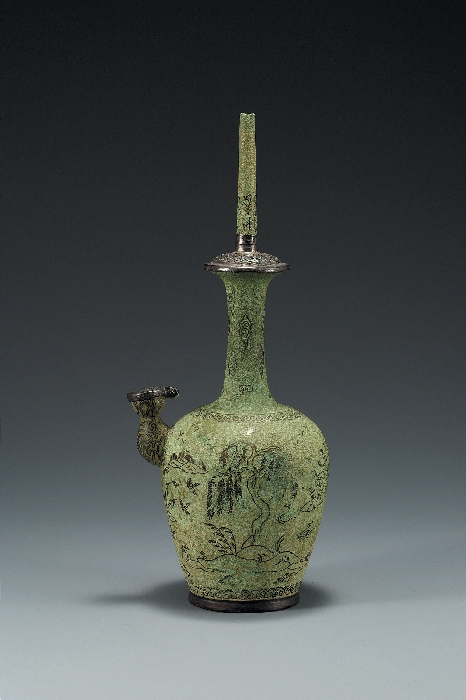- 다른명칭
국보 청동 은입사 포류수금문 정병(1962), 靑銅銀入絲蒲柳水禽文淨甁
- 전시명칭
물가풍경무늬 정병
- 국적/시대
한국 - 고려
- 재질
금속 - 동합금
- 분류
종교신앙 - 불교 - 공양 - 정병
- 크기
높이 37.5cm, 입지름 1.1cm, 몸통지름 12.9cm, 바닥지름 8.6cm
- 지정문화유산
국보
- 소장품번호
본관2426
- 전시위치
금속공예
정병은 맑은 물을 담아두는 병으로, 본래 승려가 지녀야 할 열 여덟 가지 물건 중 하나였으나 점차 불전에 바치는 깨끗한 물을 담는 그릇으로 사용되었다. 불교의식을 할 때 쇄수게(灑水偈)를 행하면서 의식을 인도하는 승려가 솔가지로 감로수를 뿌림으로써 모든 마귀와 번뇌를 물리치도록 할 때 사용되기도 한다. 고려시대의 정병은 대체로 몸체가 계란형이며, 매끈하게 빠진 긴 목 위로 뚜껑 형태의 둥근 테가 놓인다. 그 위로 다시 대롱형의 물을 넣고 빼는 첨대(尖臺)가 솟아 있으며, 몸체 한쪽에는 중간을 잘록하게 좁힌 비녀처럼 생긴 귀때[注口]가 튀어나와 있다. 정병은 물가의 풍경을 담아냈는데, 언덕 위로 길게 늘어진 버드나무, 물 위로 노를 저어가는 어부와 낚시꾼 등이 마치 한 폭의 그림을 보는 듯한 아름다운 정경이다. 이 모든 풍광이 표면에 홈을 파서 은선을 두드려 박는 은입사 기법으로 장식되었다. 병의 긴 목에는 구름무늬, 동체의 어깨와 굽 주위에는 여의두무늬[如意頭文], 귀때에는 풀무늬[草文]가 입사되었다. 은을 돌린 굽은 지금은 파랗게 녹슨 몸체와 어울려 독특한 분위기를 자아내고 있다. 청동제의 병에 은상감을 한 예는 적지 않으며, 이러한 기법이 고려청자에도 통용되어 주목된다.

유의사항
- 지정문화유산의 실물 복제품을 제작하고자 하는 경우는 별도의 허가 신청이 필요합니다.
 이 누리집은 대한민국 공식 전자정부 누리집입니다.
이 누리집은 대한민국 공식 전자정부 누리집입니다.



 X
X  페이스북
페이스북 

















































